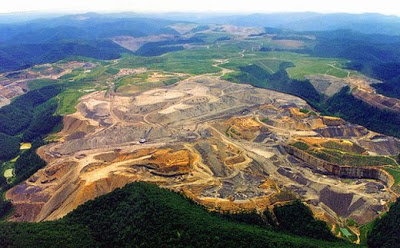Mountaintop removal receives major setback:
Blair Mountain in West Virginia named to National Register of Historic Places
By Jeff Biggers / March 30, 2009
After 500 mountains in Appalachia have been blown to bits by mountaintop removal, one peak was most likely saved today: Blair Mountain in West Virginia, the site of the largest armed insurrection in the United States since the Civil War, was officially approved by the Keeper of the National Register of Historic Places to be placed on the National Register.
This is a huge victory, as the tide continues to turn in the movement to stop mountaintop removal in Appalachia.
Some consider it the Bunker Hill of the labor movement. But the great battle in 1921, when thousands of union coal miners and World War I veterans donned their uniforms and took up arms to liberate and unionize the last coal camps in southwestern West Virginia held hostage to ruthless outside coal companies, has emerged as one of the great symbols of Appalachia’s fate today. Over the past several years, the Friends of Blair Mountain–an organization of community and labor activists, historians and environmentalists–have led an even more epic battle to save the sacred mountain site from a plan by coal companies to strip mine and destroy Blair Mountain through mountaintop removal operations.
The mountaintop removal war might soon be over. The Rednecks won. According to the National Registry Federal Program regulations:
“If a property contains surface coal resources and is listed in the National Register, certain provisions of the Surface Mining and Control Act of 1977 require consideration of a property’s historic values in the determination on issuance of a surface coal mining permit.”
“Redneck” was the name given to the progressive miners, as William Blizzard recalled in his wonderful memoir, When Miners March, as they wore red bandannas around their necks to distinguish themselves from others. As the battle raged, and even bombs dropped, President Warren Harding was forced to intervene with military troops.
President Barack Obama needs to intervene against mountaintop removal today. As three million pounds of ammonium nitrate fuel oil are detonated daily in an assault on Appalachia today, raining toxic dust on the inhabitants and devastating watersheds as part of the brutal mountaintop removal operations, it’s time for the federal government to stop this egregious violation of human rights in the mountains.
Cecil Roberts, the president of the United Mine Workers of America, and a great West Virginia coal mining native, should take note of the haunting parallels in history: While over 500 mountains have been destroyed, the once strong union movement has been gutted by highly mechanized strip mining operations, and now only 500-700 United Mine Worker members are employed on mountaintop removal sites in West Virginia.
Let’s repeat that: There are roughly 700 UMWA members employed at mountaintop removal sites in West Virginia today.
It’s time for Cecil Roberts and the United Mine Workers to stand up for the mountains, the historic Appalachian communities, and the economy, and demand an end to mountaintop removal, and a return to more responsible mining.
Ken Ward at the Coal Tattoo blog recently looked at Roberts and mountaintop removal.
And to learn about other endangered American mountains, go here.
Denise Giardina, the nationally acclaimed novelist from the coalfields of West Virginia, and author of the epic novel, Storming Heaven, once wrote:
“In the hundred odd years since the coal industry came to this part of West Virginia, land has been taken, miners have been worked to death, streams have been polluted, piles of waste have accumulated, children have grown up in poverty. But throughout all the hardships, the hunger, the black lung disease and other illness, and the scarring of the land, the mountains have essentially remained. They were symbols of permanence, strength, hope. No more. Nothing worse can be taken from mountain people than mountains. The resulting loss is destroying the soul of the people.
The destruction of the central Appalachian Mountains robs the region of topsoil, timber, of indigenous plants, of streams, and leaves behind floods, toxic brews of sludge laced with mercury, and flattened plains of inedible grass. But worst of all is the loss of the mountain landscape, those rugged crags that lift the spirits and touch the sky.
If one mountain were to be spared, one peak to bear mute witness to the devastation that has gone on all around, it might be thought that Blair Mountain would be such a summit. Blair Mountain, after all, has been the most dramatic witness to the struggle of legions of coal miners to be free.”
If only William Blizzard, the author of When Miners March, were alive today to take part in this celebration. His father, Bill Blizzard, the hero of Blair Mountain, was tried and acquitted for treason. For more information, see: http://www.whenminersmarch.com/reviews.htm
Filmmaker Sasha Waters did a great documentary on the importance of Blair Mountain in her film, Razing Appalachia:
Source / The Huffington Post
Thanks to Carl Davidson / The Rag Blog



















This was an excellent post, and based on fact and history that can’t be disputed.